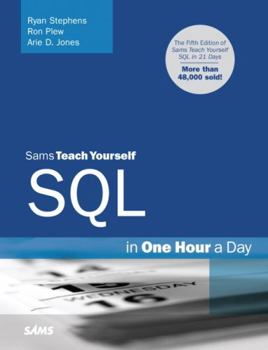Sams Teach Yourself SQL in One Hour a Day
The Fifth Edition of Sams Teach Yourself SQL in 21 Days More than 48,000 sold In just one hour a day, you'll have all the skills you need to begin creating effective SQL queries, reports, and database applications. With this complete tutorial, you'll quickly master the basics and then move on to more advanced features and concepts: Quickly apply essential SQL techniques in useful, real-world queries Design trustworthy, high-performance databases Manipulate your data with views and transactions Leverage powerful features including stored procedures, triggers, and cursors Work with new objects introduced with the latest SQL standards Get practical, expert tips on implementing SQL in your business environment Learn on your own time, at your own pace No previous SQL or database experience required Learn techniques that work with any current version of SQL Discover how to write faster, more efficient queries Secure your data using best practices from experienced database administrators Build more powerful databases with features exclusive to Oracle SQL*Plus, Oracle PL/SQL, and Microsoft Transact-SQL Write queries for the free, open source MySQL database Embed your SQL code in other applications Ryan Stephens and Ron Plew are President and VP of Perpetual Technologies, Inc. (PTI) in Indianapolis, IN, providing managed services and consulting for top database implementations running Oracle, SQL Server, and other leading technologies. They taught for 5+ years as adjunct professors at Indiana University-Purdue University. Their books include Sams Teach Yourself SQL in 24 Hours, First through Fourth Editions, Sams Teach Yourself SQL in 21 Days, Second through Fourth Editions, and Database Design. Table of Contents Introduction 1 PART I: Introducing SQL LESSON 1: Getting Started with SQL 5 A Brief History of SQL 5 A Brief History of Databases 6 Today's Database Landscape 11 A Cross-Product Language 12 Early Implementations 12 SQL and Client/Server Application Development 13 An Overview of SQL 13 Popular SQL Implementations 14 MySQL 14 Oracle 14 Microsoft SQL Server and Sybase 15 IBM DB2 16 Open Database Connectivity 16 Embedding SQL in Application Programming 17 LESSON 2: Introducing the Query 21 Exploring SQL's Background 21 Learning Basic Query Syntax 22 The Building Blocks of Data Retrieval: SELECT and FROM 23 Applying Query Concepts 25 Writing Your First Query 26 Terminating a SQL Statement 28 Selecting Individual Columns 28 Changing the Order of the Columns 29 Selecting Different Tables 31 Selecting Distinct Values 31 Exercises 37 LESSON 3: Expressions, Conditions, and Operators 39 Working with Query Expressions 40 Placing Conditions on Queries 40 Learning How to Use Operators 42 Arithmetic Operators 42 Comparison Operators 55 Character Operators 63 Logical Operators 70 Set Operators 75 Miscellaneous Operators: IN and BETWEEN 78 LESSON 4: Clauses in SQL Queries 85 Specifying Criteria with the WHERE Clause 87 Order from Chaos: The ORDER BY Clause 89 The GROUP BY Clause 98 The HAVING Clause 105 Combining Clauses 112 Example 4.1 112 Example 4.2 113 Example 4.3 113 Example 4.4 115 LESSON 5: Joining Tables 121 Joining Multiple Tables in a Single SELECT Statement 121 Cross Joining Tables 123 Finding the Correct Column 128 Joining Tables Based on Equality 129 Joining Tables Based on Nonequality 137 OUTER JOINs Versus INNER JOINs 139 Joining a Table to Itself: The Self Join 143 LESSON 6: Embedding Subqueries into Queries 151 Building a Subquery 153 Using Aggregate Functions with Subqueries 160 Nesting Subqueries 162 Referencing Outside with Correlated Subqueries 166 Using EXISTS, ANY, and ALL 169 LESSON 7: Molding Data with Built-in Functions 179 Using Aggregate Functions to Summarize Data 180 COUNT 180 SUM 181 AVG 182 MAX 184 MIN 185 VARIANCE 186 STDDEV 186 Using Functions to Format Date and Time Values 187 ADD_MONTHS/ADD_DATE 188 LAST_DAY 190 MONTHS_BETWEEN 191 NEXT_DAY 193 SYSDATE 193 Using Functions for Arithmetic Operations 195 ABS 195 CEIL and FLOOR 196 EXP 196 LN and LOG 197 MOD 198 POWER 199 SIGN 199 SQRT 200 Using Functions to Modify the Appearance of Character Values 201 CHR 201 CONCAT 202 INITCAP 203 LOWER and UPPER 203 LPAD and RPAD 205 LTRIM and RTRIM 206 REPLACE 207 SUBSTR 209 TRANSLATE 213 INSTR 214 LENGTH 214 Conversion Functions 215 TO_CHAR 215 TO_NUMBER 217 Miscellaneous Functions 217 GREATEST and LEAST 217 USER 218 Supplemental Examples of MySQL Character Functions 219 LENGTH 219 LOCATE 219 INSTR 220 LPAD 220 RPAD 220 LEFT 220 RIGHT 221 SUBSTRING 221 LTRIM 221 RTRIM 222 TRIM 222 Supplemental Examples of MySQL Date Functions 222 DATE_FORMAT 223 TIME_FORMAT 224 CURDATE 224 CURTIME 225 PART II: Database Design LESSON 8: Database Normalization 229 Normalizing a Database 229 The Raw Database 229 Logical Database Design 230 The Needs of the End User 230 Data Redundancy 231 Understanding the Normal Forms 231 The First Normal Form 232 The Second Normal Form 233 The Third Normal Form 234 Making Normalization Work 235 Referential Integrity 235 Benefits of Normalization 236 Drawbacks of Normaliza
Format:Paperback
Language:English
ISBN:0672330253
ISBN13:9780672330254
Release Date:January 2009
Publisher:Sams Publishing
Length:814 Pages
Weight:0.65 lbs.
Dimensions:1.7" x 7.0" x 9.1"
Customer Reviews
0 rating





